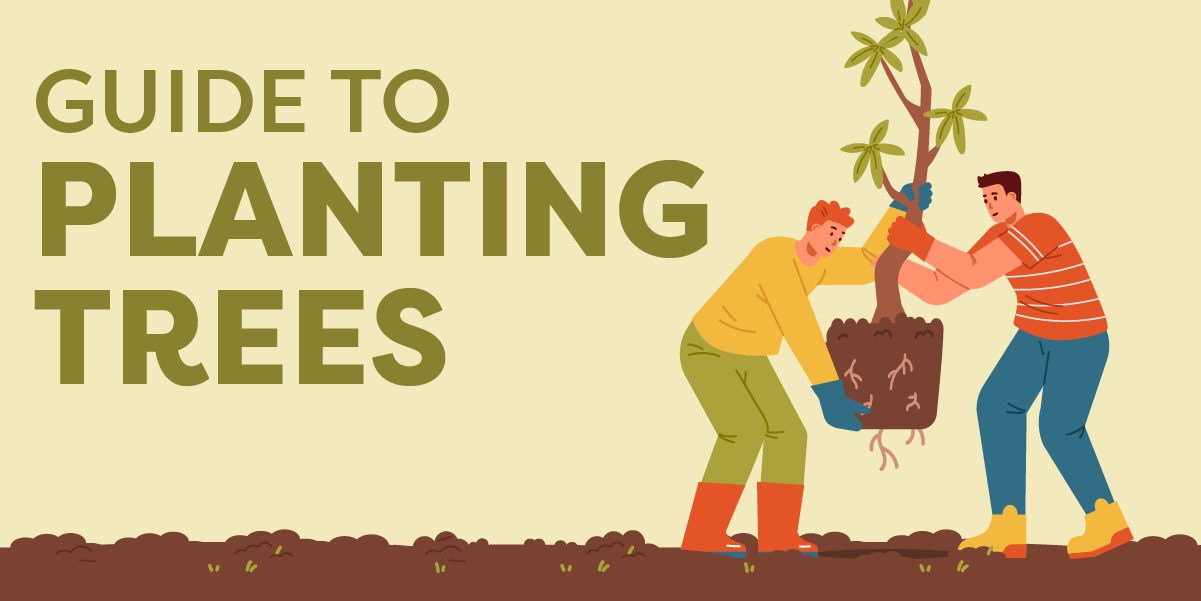Mighty oaks from little acorns grow.
And if you wait a thousand years, a little acorn might drop in the precise location where you’d like an oak tree in your yard.
But if you want that oak tree sooner, you might have to take matters into your own hands. How hard can that be? You dig a hole in the ground and stick a tree in it! Problem solved! …Until the tree withers and dies.
There’s an art to planting trees for health and vigorous growth, which we’re about to discuss.
Choosing the Right Tree for SoCal
- Identify your Hardiness Zone: Look up your gardening zone before you go tree shopping. The Sunset magazine set of zones was designed for the West Coast and has become a standard reference.
- Native Trees vs. Non-native Trees: Native trees have adapted to the region’s climate and are generally more resistant to pests and diseases. Drought-resistant, non-native trees can also thrive in Southern California with proper care.
- Size & Growth Rate: You don’t want a tree that will outgrow its space and damage property. Also, consider the tree’s growth rate — do you want shade and privacy ASAP, or are you willing to wait longer for a slower-growing tree?
- Soil & Sunlight Conditions: Different trees require different soil and sunlight conditions. Make sure the tree you choose is suitable for the soil in your yard and the sunlight it will receive.
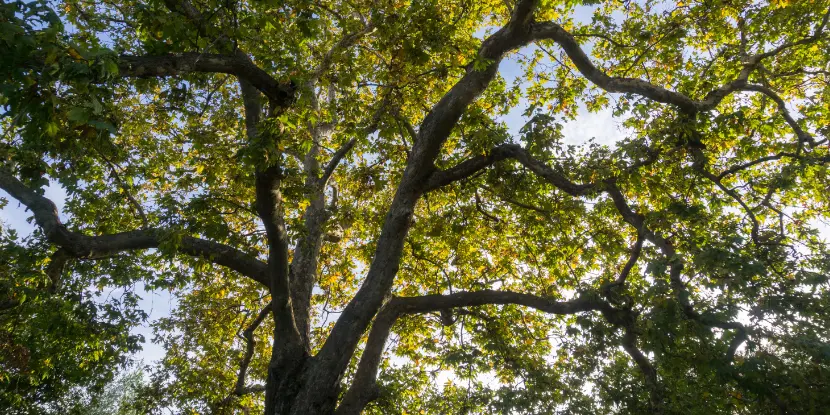
A fully grown Western Sycamore (Platanus racemosa), native to California.
Planting the Tree
- A good spot should have enough space for the tree to grow to its full potential, with no obstructions like power lines or buildings.
- The hole should be twice as wide as the root ball of the tree and deep enough that the top of the root ball is level with the surrounding ground.
- Use a shovel or hoe to loosen and aerate the soil in and around the planting hole. Remove any rocks, sticks, or other debris in the planting hole that could hinder root growth.
- Pull the plant from its container, holding it by the root ball, not the trunk. Set the root ball in the planting hole. The top of the root ball should be level or slightly higher than the surrounding soil. In heavy clay soil, raise the root ball 2 inches above ground for every 10-gallon container size.
- Mix 1 cup gypsum with every 5 gallons of soil removed from the hole. Return the soil as backfill up to the halfway mark of the hole.
- Spread time-release fertilizer for trees around the tree roots. Add the remaining soil, filling the hole to ground level. Firm the soil to eliminate air pockets.
- Build a water basin around the plant for easy watering in the first year. Water thoroughly once a week, using 5 gallons of water with 1/2 teaspoon of plant growth stimulant. 5 gallons of water are equivalent to 1 inch of rainfall, so adjust your watering to account for weather conditions and water from sprinklers.
- Apply a thick layer (4 feet deep and 2 feet wide) of shredded mulch over the soil area to conserve moisture, discourage weeds, and buffer root temperatures.
- For the first two months, use a root stimulator (3 1/2 tablespoons per gallon of water). This will encourage faster rooting and lessen transplant shock.
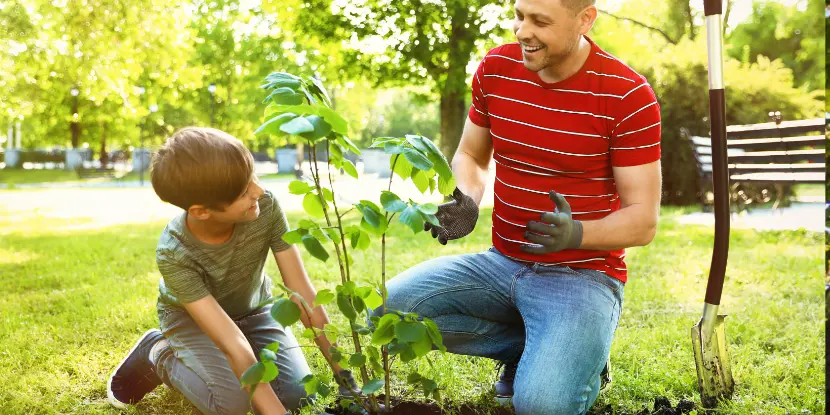
A father and son plant a tree together
Growing Tips for Trees & Shrubs
Water
- Each young tree or shrub needs 1 to 15 gallons of water once a week. During drought periods or in very sandy soil, increase watering frequency to every 5 days. Conversely, reduce watering frequency to every 10 to 14 days during abnormally wet periods or in very heavy soil to prevent root rot.
- Employ deep watering techniques to ensure that water reaches the tree roots. Use drip irrigation systems or soaker hoses to administer water slowly and effectively, reducing runoff and ensuring deep soil penetration.
- Apply a 2 to 4-inch layer of shredded mulch around the tree’s base. Mulch conserves soil moisture, regulates temperature, and suppresses weeds. Leave a few inches of space between the mulch and the tree trunk to prevent rot.
- Regularly check soil moisture levels with a soil moisture meter or finger test. Insert your finger into the soil up to the second knuckle; if it feels dry, it’s time to water.
- Adjust your irrigation schedule based on the season. Trees and shrubs need more water during the hot, dry summer months.
Fertilizer
- Supplement soil nutrients with slow-release fertilizers, which provide a steady flow of essential elements throughout the growing season. Apply fertilizer once in early spring and again in late summer.
- Use organic fertilizers to improve soil health and promote microbial activity vital for nutrient absorption.
Disease
- Watch for lesions or occasional leaf spots.
- Prune any damaged parts.
- Spray the tree with a fungicide if necessary.
- If you’re unsure about a problem, bring a sample of the affected plant to Anawalt Lumber & Hardware and have one of our nursery professionals assist you.
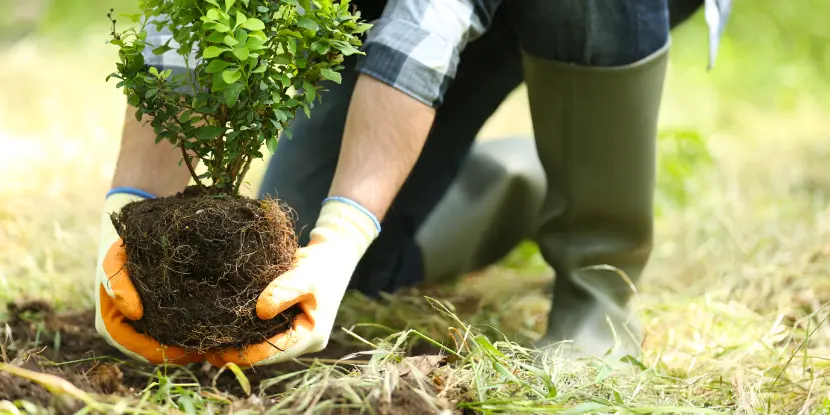
A gardener gently handling a young shrub by the root ball.
Pest Control
- Inspect trees regularly for signs of pests, such as holes in the trunk or leaves, chewed foliage, or sticky residue on branches.
- Encourage beneficial insects by planting flowers and herbs in your garden that attract them.
- Consider using natural remedies or organic pesticides to manage pest populations. Organic control methods include neem oil, beneficial predatory insects, and hand-picking pests.
- If pests are out of control, consult a professional for safe and effective treatment options.
Pruning
- Remove dead, damaged, or diseased branches as soon as you notice them. Prune during the dormant season (late winter or early spring) to encourage vigorous growth and reduce stress on the tree.
- Use clean and sharp pruning tools to prevent damage to the tree.
- Avoid over-pruning; never remove more than 30% of a tree’s branches in one season.
- Consult a professional or do research before attempting to prune large trees. It can be dangerous and requires special equipment.
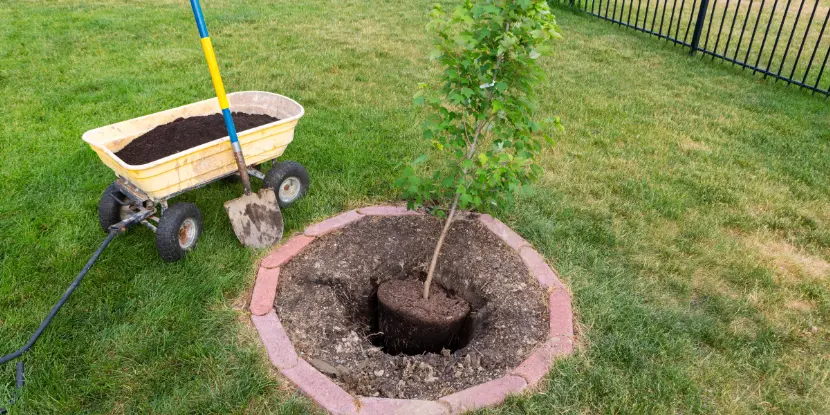
A young tree being planted in the yard.
Weeds & Grass
- For the first year, pull weeds under the tree canopy to clean the mulch area.
- After the first year, spreading herbicide is a viable option for weed control. However, be careful not to damage tree roots.
- Use a grass barrier or gravel bed to reduce weed growth around the tree’s base.
Conclusion
You’ve done it, Johnny Appleseed! Successfully planted a tree for the betterment of your yard, the neighborhood, and America!
Now reward yourself with a cool one, pull up a lawn chair, and watch that tree grow!
Remember that your Anawalt nursery professional is here to help; visit any of our Los Angeles locations for sound gardening advice, attend summer events, and take advantage of the sales on plants, gardening supplies, and tools.
FAQs: Planting a Tree in Southern California
Q: What are the best tree species to plant in Southern California?
Recommended species include the Coast Live Oak, Western Redbud, California Sycamore, and California Pepper tree. These species are well-adapted to the region’s climate and offer aesthetic appeal and resilience.
Q: How often should trees be watered in the Southern California climate?
In general, newly planted trees require more frequent watering, about twice a week, which can be scaled back to once a week after the first year. Depending on the season and rainfall, mature trees can be watered less frequently.
Q: What’s the optimal season for planting trees in this region?
The best time to plant trees in Southern California is during the fall. This allows the trees to establish their root systems during the cooler months before the dry, hot summer sets in.
Q: Are local regulations or permits required for planting trees in Southern California?
Permits may be required in some areas, especially for specific species or when planting in public spaces or near utility lines. Check with local city or county government offices.
Q: How can I protect my trees from common pests?
Regular monitoring, proper watering, and maintaining tree health are crucial. Environmentally friendly pest control options like beneficial insects or organic pesticides can be effective for certain pests.
Q: What soil amendments are recommended for tree planting in this area?
We recommend compost and mulch to improve soil structure and fertility, ensure better water retention, and provide necessary nutrients for tree growth.
Q: How much space should I allow between newly planted trees?
The spacing depends on the mature size of the tree species. A general rule is to space trees 10 to 20 feet apart to ensure enough room for growth and prevent crowding.
Q: What are the signs of water stress in trees, and how can it be mitigated?
Signs include wilting leaves, yellowing, and premature leaf drop. Mitigation involves adjusting watering schedules, mulching to retain soil moisture, and possibly consulting a tree care specialist.
Q: Which fertilizers are best suited for trees in Southern California?
We recommend a balanced, slow-release fertilizer. Needs may vary depending on the tree species and soil conditions, so consider testing your soil.
Q: How can I ensure my trees are resilient to drought conditions?
Choose drought-tolerant species, mulch around the base of trees to reduce evaporation, and water deeply but infrequently to encourage deep root growth.

